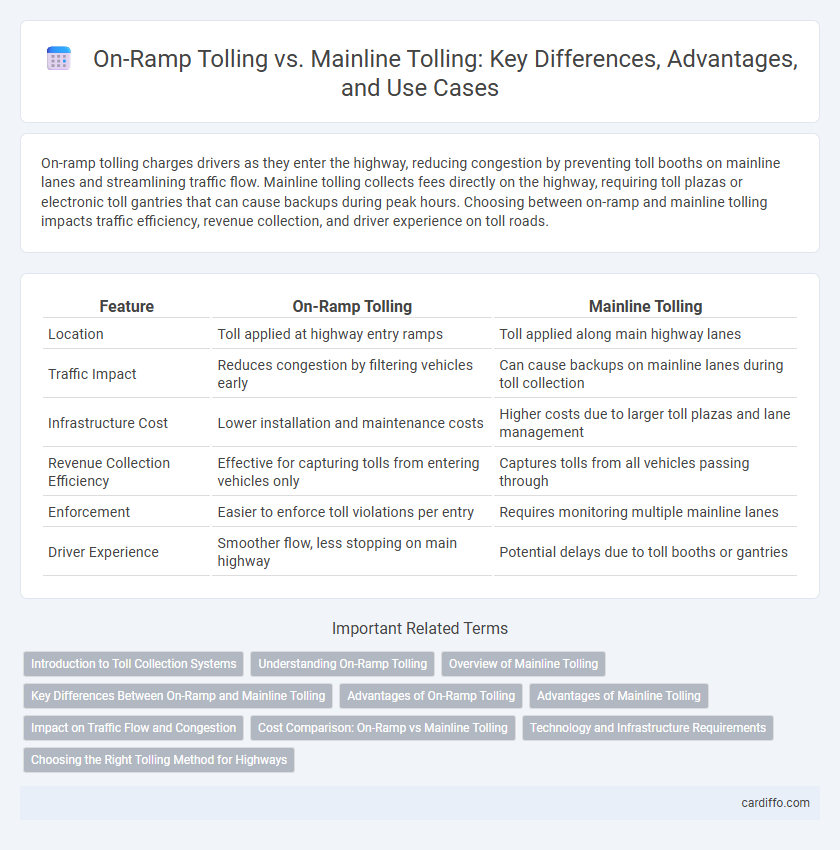On-ramp tolling charges drivers as they enter the highway, reducing congestion by preventing toll booths on mainline lanes and streamlining traffic flow. Mainline tolling collects fees directly on the highway, requiring toll plazas or electronic toll gantries that can cause backups during peak hours. Choosing between on-ramp and mainline tolling impacts traffic efficiency, revenue collection, and driver experience on toll roads.
Table of Comparison
| Feature | On-Ramp Tolling | Mainline Tolling |
|---|---|---|
| Location | Toll applied at highway entry ramps | Toll applied along main highway lanes |
| Traffic Impact | Reduces congestion by filtering vehicles early | Can cause backups on mainline lanes during toll collection |
| Infrastructure Cost | Lower installation and maintenance costs | Higher costs due to larger toll plazas and lane management |
| Revenue Collection Efficiency | Effective for capturing tolls from entering vehicles only | Captures tolls from all vehicles passing through |
| Enforcement | Easier to enforce toll violations per entry | Requires monitoring multiple mainline lanes |
| Driver Experience | Smoother flow, less stopping on main highway | Potential delays due to toll booths or gantries |
Introduction to Toll Collection Systems
On-ramp tolling collects fees as vehicles enter the highway, efficiently managing traffic flow and reducing congestion at mainline toll plazas. Mainline tolling charges vehicles at fixed points along the highway, often leading to slower traffic due to toll booth stops. Both systems integrate with electronic toll collection technologies like RFID and ANPR for seamless and automated payment processing.
Understanding On-Ramp Tolling
On-ramp tolling charges drivers as they enter the highway, targeting specific access points to manage traffic flow and reduce congestion effectively. This method contrasts with mainline tolling, which collects fees on primary highway segments and can lead to bottlenecks during peak hours. Understanding on-ramp tolling helps optimize revenue collection by minimizing delays and enhancing traffic distribution across toll facilities.
Overview of Mainline Tolling
Mainline tolling utilizes electronic toll collection systems installed along the highway, allowing vehicles to pay tolls at highway speed without stopping. This method reduces congestion and improves traffic flow by eliminating toll booths and enabling seamless toll processing through RFID transponders or license plate recognition. The efficiency of mainline tolling supports sustainable highway operations and enhances revenue collection accuracy.
Key Differences Between On-Ramp and Mainline Tolling
On-ramp tolling charges vehicles as they enter the toll facility, targeting specific entry points for fee collection, while mainline tolling collects fees along the highway without requiring exits. On-ramp tolling minimizes congestion by distributing toll plazas at entry points, whereas mainline tolling can create bottlenecks due to centralized toll collection. Additionally, on-ramp tolling often uses gantries equipped with electronic toll collection, improving traffic flow efficiency compared to mainline tolling systems.
Advantages of On-Ramp Tolling
On-ramp tolling optimizes traffic flow by reducing congestion at mainline toll plazas, enabling smoother vehicle movement and shorter travel times. This method enhances safety by minimizing abrupt stops and lane changes near toll collection points. Operational costs are lowered due to fewer toll booths and less infrastructure, resulting in more efficient toll collection and maintenance.
Advantages of Mainline Tolling
Mainline tolling offers significant advantages by enabling seamless traffic flow without requiring vehicles to slow down or stop at toll booths, reducing congestion and travel time on highways. Its electronic toll collection systems increase efficiency and accuracy, minimizing human error and operational costs. This approach also enhances safety by eliminating hazardous toll plaza merges and reducing vehicle emissions due to less idling.
Impact on Traffic Flow and Congestion
On-ramp tolling effectively reduces mainline congestion by diverting toll collection to entry points, minimizing slowdowns on freeway mainlines and maintaining steady traffic flow. In contrast, mainline tolling can create significant bottlenecks as all vehicles must stop or slow down at toll plazas, leading to increased delays and higher congestion levels. Data shows that on-ramp tolling systems improve overall traffic throughput by up to 25% compared to traditional mainline tolling setups.
Cost Comparison: On-Ramp vs Mainline Tolling
On-ramp tolling typically incurs lower infrastructure and maintenance costs compared to mainline tolling, as it uses fewer gantries and less complex electronic toll collection systems. Mainline tolling requires extensive equipment installation across the entire highway, leading to higher capital and operational expenses. Cost efficiency of on-ramp tolling makes it a preferred option for reducing overall toll collection investments while maintaining revenue.
Technology and Infrastructure Requirements
On-ramp tolling requires advanced sensor arrays and vehicle detection systems at highway entry points, demanding precise infrastructure such as RFID readers or ANPR cameras integrated with traffic management platforms. Mainline tolling involves substantial investment in gantry-mounted electronic toll collection devices and centralized processing centers, supporting high-speed vehicle identification without disrupting traffic flow. Both systems rely heavily on real-time data transmission networks and robust billing software to ensure accurate toll calculation and enforcement.
Choosing the Right Tolling Method for Highways
On-ramp tolling collects fees at highway entry points, reducing congestion by preventing toll queues on the mainline but requiring extensive infrastructure at multiple ramps. Mainline tolling charges vehicles at designated highway segments, offering streamlined operation with fewer toll points but potentially causing traffic slowdowns during peak hours. Selecting the optimal tolling method depends on traffic volume, highway design, and cost-efficiency, balancing user convenience with operational effectiveness.
On-Ramp Tolling vs Mainline Tolling Infographic

 cardiffo.com
cardiffo.com